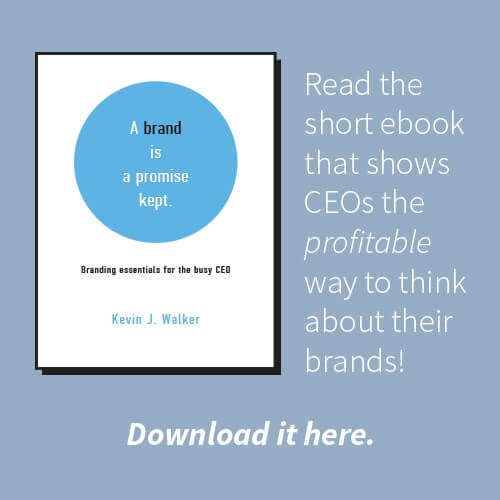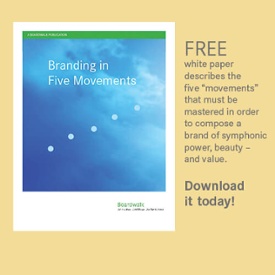 Most businesses, whether startups or mature, have no real inkling what their brand promise is or what it should be. As I’ve written here before, most businesses are marketing in the dark. They try different tactics, they mail out a new brochure, they launch a new website, they switch from Instagram to Snapchat, they build a bigger booth at the trade show. When one thing doesn’t work, they try another. But they’re uncertain as to where there may be obstacles, barriers or pitfalls. So there’s never much in the way of sustained effort. There’s seldom any real strategy to guide what tactics to use, in what order and with what degree of intensity. When people have to drive up sales, rapidly, they usually get straight to marketing and selling stuff. They almost never stop to reflect on what is problem that they’re really solving. More to the point, they never stop to think about who is doing the marketing and how can we get customers to fall in love with that who. Here’s how to start that process.
Most businesses, whether startups or mature, have no real inkling what their brand promise is or what it should be. As I’ve written here before, most businesses are marketing in the dark. They try different tactics, they mail out a new brochure, they launch a new website, they switch from Instagram to Snapchat, they build a bigger booth at the trade show. When one thing doesn’t work, they try another. But they’re uncertain as to where there may be obstacles, barriers or pitfalls. So there’s never much in the way of sustained effort. There’s seldom any real strategy to guide what tactics to use, in what order and with what degree of intensity. When people have to drive up sales, rapidly, they usually get straight to marketing and selling stuff. They almost never stop to reflect on what is problem that they’re really solving. More to the point, they never stop to think about who is doing the marketing and how can we get customers to fall in love with that who. Here’s how to start that process.
Stop. Take a breath. Let’s begin by asking what purpose your business serves in society. Why is it here? Why does it get to take up space? The answer to this will be your Purpose Statement. The Purpose Statement is where any brand strategy should begin. The Purpose Statement is sometimes referred to as an Ideals Statement or a Why Statement.
The Purpose Statement is a very different thing than your Mission Statement. The Purpose Statement defines the problem you are here to solve, whereas the Mission Statement describes how you mean to fulfill your purpose. The Mission Statement is written from your point of view: “The XYZ Corporation aims to be the premier supplier of blah, blah, blah.” The Purpose Statement is written from your ideal customer’s point of view: “The XYZ Corporation exists to (solve my most pressing problem)”.
One of the most difficult things any business needs to figure out is what their customers really want. The customers, themselves, often don’t know. Henry Ford famously pointed out, “If I asked them what they wanted, they would have said faster horses.”
Then there’s the illustration of the drill. A man walks into Murphy’s Hardware store and asks where they keep the drills. “You want to buy a drill?”, asks Murphy. But the man doesn’t really want a drill. Nobody wants a drill. What the man wants is a hole. He just needs a drill to make one. But nobody wants just a hole either. In this case, the man wants a hole so he can easily place a nail in the wall. But nobody wants just a nail in the wall, either. What the man really wanted was to enjoy a painting that was hung from the nail that was inserted into the hole that was bored by the drill that the man bought at Murphy’s Hardware store. So, in this illustration, the Purpose Statement is: Murphy’s Hardware store exists to facilitate art appreciation. You can see how it can be exasperating and confusing.
When we work with our clients to figure out their own true purpose, we’ve seen it is a very difficult process indeed. We like to ask them to write a first draft of the Purpose Statement, just as a starting point, a hypothesis. Then we interview various of the businesses’ constituencies to test the hypothesis. After gleaning as much insight as we can, we adjust the Purpose Statement accordingly. But it can be agonizingly painful to write that first draft. There is nothing quite as intimidating as a blank sheet of paper. So, we came up with a methodology to jump start the process. We’re leveraging some of the findings that Jim Stengel reveals in his excellent book, Grow, from Virgin Books. In it, he shows that the 50 fastest-growing companies in the world have Ideals Statements (as he refers to them) that falls into just five categories. Below, are listed the five categories as well as one of the Stengel 50 companies associated with that category, and its Purpose Statement.
We’re leveraging some of the findings that Jim Stengel reveals in his excellent book, Grow, from Virgin Books. In it, he shows that the 50 fastest-growing companies in the world have Ideals Statements (as he refers to them) that falls into just five categories. Below, are listed the five categories as well as one of the Stengel 50 companies associated with that category, and its Purpose Statement.
Category Company and Purpose Statement
to Elicit Joy Coca-Cola exists to inspire moments of happiness.
to Enable Connection Fed-Ex exists to deliver peace of mind to everyday interactions.
to Inspire Exploration Apple exists to empower creative exploration and self-expression.
to Evoke Pride Mercedes-Benz exists to epitomize a life of achievement.
to Impact Society Dove exists to celebrate every woman’s unique beauty.
These days, before we ask them to write the first draft of their Purpose Statement, we have our clients to choose the category, from the left column, that best describes their own business. With that in mind, it’s much easier to figure out what they actually do for their customers. Of course, this is just the beginning of the process. We still need to do the qualitative research. We still need to go out and interview all the company’s constituencies. We still need to survey our client’s competitive environment. Once the legwork is done, we get back to analyze the findings, revisit the Purpose Statement, revising and refining it as necessary.
Now, before dismissing Jim Stengel’s “five categories” as some kind of gimmick, remember that this categorization is the one thing he discovered, after a decade-long study, that all these companies had in common. Remember too that these are the 50 fastest-growing companies in the world. And remember they are all market leaders, well worth emulating.
Try it for your own company. Which category best describes you? And what Purpose Statement would that lead you to write?
Best Branding Reads – Week of August 22, 2016
As enrollment declines, L.A. public schools borrow a tactic from the charters: marketing
Private, charter, magnet, religious schools and home schooling – public schools, today, have plenty of competition.
5 worrying truths about the state of B2B customer experience (Infographic)
Mind-blower of the month: 80% of B2B customers base their buying decisions on CX rather than price.
Apple drops Apple Store branding
Subtle change, but Apple adds a ton of cachet with this move. Luxury marketing!
The Erotics of Branding in Design and Relationships
When organizations and their markets fall in love with each other, a little baby brand is born.
The untold story of Boston’s iconic Citgo sign
I really had no idea Boston had this landmark and was so in love with it.
New Logo and Identity for British Fencing
Glad to see some branding that presents fencing as the exciting modern sport that it is.
Make Your Brand Story Meaningful
An older article but I only just happened on it and it’s definitely worth reading.




